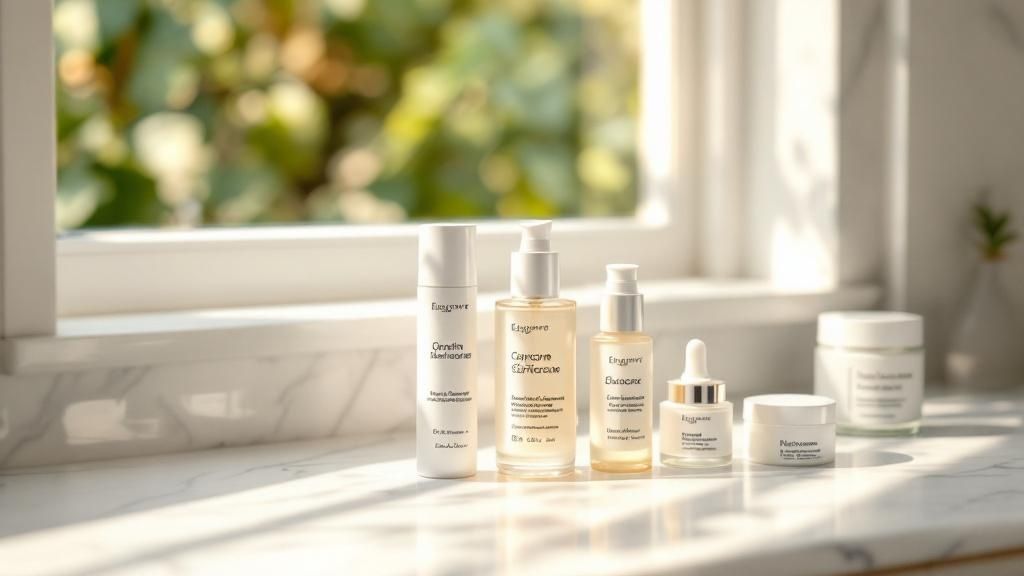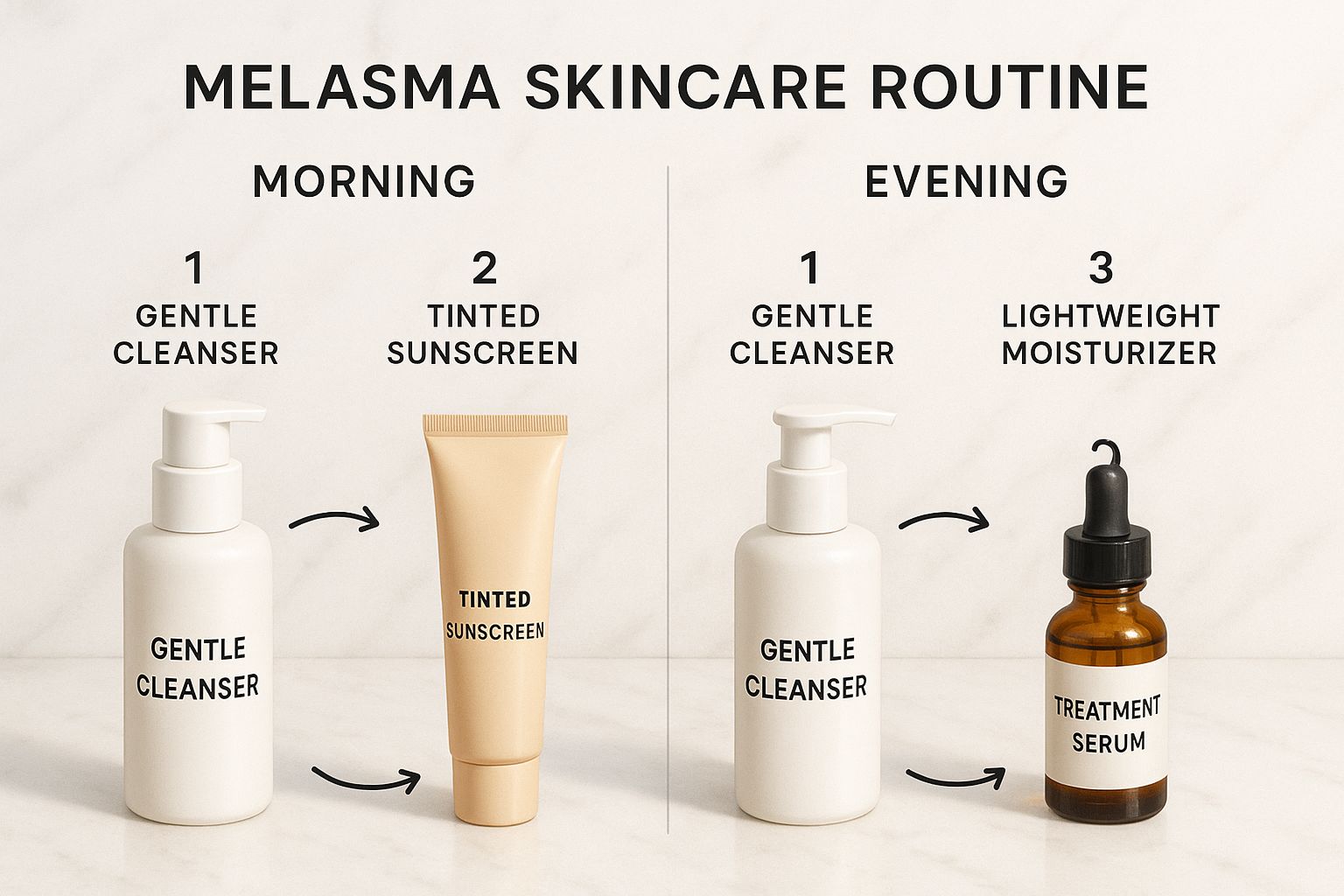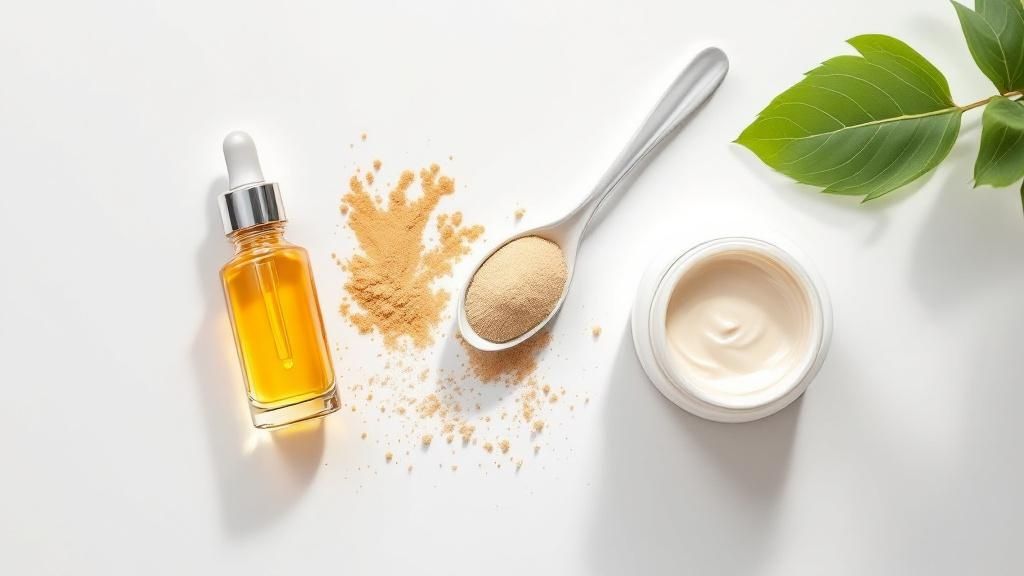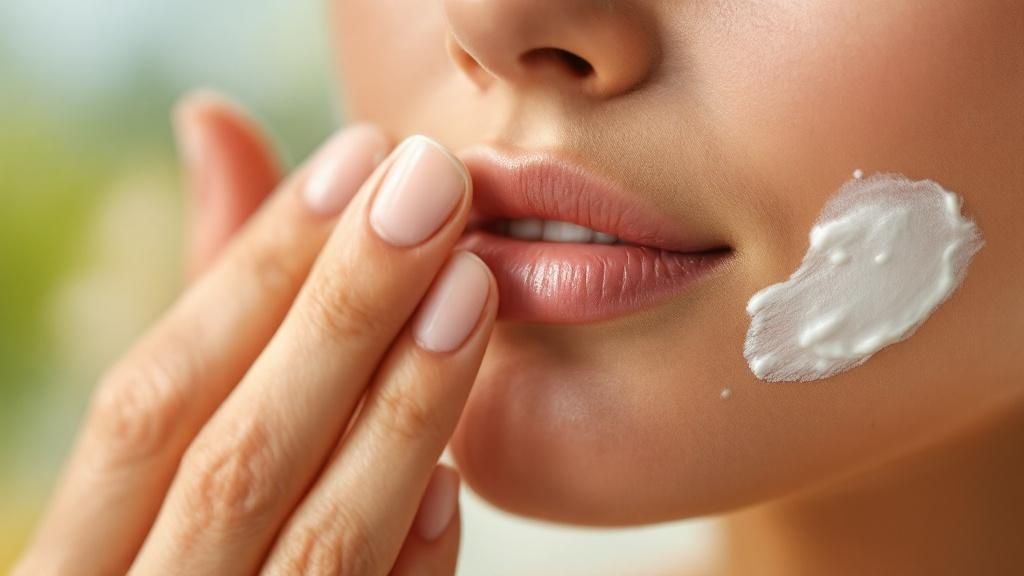
If you've ever felt frustrated after trying a standard brightening serum on your melasma with little to no change, you're not alone. It’s a common story. Melasma isn't just a simple dark spot; it's a complex and chronic skin condition with roots far deeper than the surface.
To get real results, you need a melasma skincare routine that does two things exceptionally well: protect your skin from its triggers and correct the pigmentation that’s already there. This dual-action strategy is non-negotiable.
Why a Targeted Melasma Routine Is Everything
Unlike other forms of hyperpigmentation, melasma is driven by a powerful trio of internal and external triggers. A generic approach almost always fails because it doesn't account for the specific cellular chaos happening beneath your skin.
Understanding what's really going on is the first step toward building a routine that finally works.
The Real Triggers Behind Melasma
At its core, melasma happens when your melanocytes—the cells that produce pigment—go into overdrive. They churn out too much melanin, which then clumps together to form those signature patchy, symmetrical marks on the face.
The main culprits that flip this switch are:
- Hormonal Fluctuations: This is exactly why melasma is often called the "mask of pregnancy." Shifts in estrogen and progesterone from pregnancy, birth control, or even stress can send your pigment cells a signal to overproduce.
- Sun Exposure: This is a big one. UV radiation and even visible light from the sun and our screens are powerful stimulants for melanin production. Just a tiny bit of unprotected sun exposure can darken existing melasma or trigger a brand-new flare-up.
- Genetic Predisposition: Unfortunately, some of us are simply more genetically prone to developing melasma. This is especially true for those with more richly pigmented skin tones (Fitzpatrick skin types III-VI).
This complex interplay of factors is precisely why a one-size-fits-all product rarely makes a dent. Your routine has to be strategic, addressing each of these triggers with precision.
The Growing Search for Real Solutions
You are definitely not the only one looking for answers. In fact, global interest in melasma has skyrocketed. Worldwide internet searches for the condition shot up by an average of 54.4% between 2000 and 2019.
This surge in awareness underscores the urgent need for effective, targeted skincare solutions that people can truly depend on. You can explore the full analysis of these global melasma trends to learn more about this data.
A successful melasma management plan isn't about finding a single "cure." It's about committing to a consistent, long-term strategy that combines diligent protection with targeted corrective ingredients to keep pigment production under control.
This foundational knowledge is what sets you up for success. An effective routine isn't just about slapping on products; it's about understanding why you're using them. This intentional approach—shielding your skin from known triggers while actively fading existing discoloration—is the key to achieving a clearer, more even-toned complexion. It’s the difference between hoping for results and actually creating them.
Your Morning Routine for Protection and Prevention
Your morning melasma routine is your daily line of defense. Think of it as building a protective fortress around your skin before you even step outside. Its mission is simple but critical: shield your skin from environmental triggers—especially UV radiation and visible light—that are notorious for waking up pigment and darkening existing patches.
This defensive strategy is everything. Without it, even the most powerful corrective treatments you use at night will be fighting an uphill battle. The goal here isn't a complicated, 10-step process. It's about creating a simple yet powerful barrier that protects, neutralizes damage, and feels comfortable enough to use every single day.
Start with a Gentle Cleanse
The first step in your morning routine should be calm and restorative. You absolutely do not need a harsh, stripping cleanser to start your day. Over-cleansing can wreck your skin's delicate moisture barrier, leading to inflammation—a known accomplice in triggering melasma.
Instead, reach for a gentle, pH-balanced formula that cleanses without causing irritation or that tight, squeaky feeling. A well-formulated cleanser removes overnight buildup while leaving your skin feeling soft and hydrated, creating the perfect canvas for your antioxidant serum and, most importantly, your sunscreen.
If you're looking for a reliable option, a gentle gel cleanser that purifies without over-drying is an excellent choice.
Layer on an Antioxidant Serum
After cleansing, it's time to arm your skin with antioxidants. These are powerhouse molecules that neutralize free radicals—those unstable atoms generated by UV rays and pollution that cause cellular damage and kick melanin production into overdrive. A high-quality antioxidant serum acts as a second layer of defense, working hand-in-hand with your sunscreen.
Vitamin C is the gold standard here. It not only provides exceptional environmental protection but also helps inhibit tyrosinase, the enzyme responsible for producing melanin. Over time, this contributes to a brighter, more even skin tone. Applying a potent Vitamin C serum every single morning is one of the smartest moves you can make to bolster your skin's resilience against the daily aggressors that worsen melasma. A great example is the BARB N.P. 'Vitamin C Brightening Serum', which combines stabilized Vitamin C with other antioxidants for enhanced protection.

This visual guide shows how to sequence your products for the best results. It really helps highlight the distinct roles of your AM routine (all about protection) versus your PM routine (focused on correction) in a complete melasma management strategy.
To make things even clearer, here is a simple breakdown of your essential morning steps.
Morning Melasma Routine Step-by-Step
| Step | Product Type | Purpose | Key Ingredients |
|---|---|---|---|
| 1 | Gentle Cleanser | Remove overnight buildup without stripping the skin barrier. | pH-balanced, non-stripping surfactants, soothing agents. |
| 2 | Antioxidant Serum | Neutralize free radical damage from UV and pollution. | Vitamin C (L-ascorbic Acid), Vitamin E, Ferulic Acid. |
| 3 | Sunscreen | Provide critical protection against UVA, UVB, and visible light. | Zinc Oxide, Titanium Dioxide, Iron Oxides (for tint). |
This table serves as a quick cheat sheet for building a powerful, protective morning regimen. Following these steps consistently is the key to preventing new discoloration and protecting the progress you make with your evening treatments.
The Non-Negotiable Final Step: Sunscreen
If you do only one thing for your melasma each morning, let it be this. Applying sunscreen is the single most critical step in any melasma skincare routine—period. Without diligent, daily sun protection, every other effort is undermined.
Sun exposure is the primary trigger for melasma. Consistent protection is your key to preventing new patches from forming and stopping existing ones from getting darker. But when it comes to melasma, not all sunscreens are created equal. The type of formula you choose makes a massive difference.
Key Takeaway: For melasma-prone skin, a broad-spectrum, tinted mineral sunscreen is not just a recommendation—it's essential. This specific type offers the most complete protection against the full spectrum of light that triggers pigmentation.
Standard sunscreens do a decent job blocking UVA and UVB rays, but they often fall short when it comes to visible light—especially the blue light from the sun and our devices. We now know that visible light is a powerful trigger for melanin production, particularly in individuals with more melanin-rich skin tones.
This is where tinted mineral sunscreens truly shine.
- Mineral Actives: They use physical blockers like zinc oxide and titanium dioxide, which form a shield on the skin's surface to reflect and scatter UV rays.
- Iron Oxides: This is the game-changer. The iron oxides that provide the "tint" are what effectively block visible light. This ingredient is non-negotiable for melasma sufferers.
The prevalence of melasma varies wildly across the globe, which highlights just how much genetics and sun exposure play a role. Globally, melasma prevalence can be as low as 1% in some populations but can skyrocket to as high as 50% in others. In sunny regions and among populations with darker skin tones, like in Southeast Asia and South America, the rates are much higher. In Brazil, for instance, up to 35% of adult women may be affected.
These numbers underscore why a protective morning routine, centered on a robust sunscreen, is so critical. Applying it generously every single day—rain or shine, indoors or out—is your most powerful tool for managing this condition. BARB N.P.'s 'Sheer Mineral SPF 50' offers tinted, broad-spectrum protection that's perfect for daily defense against all light sources.
Your Evening Routine for Correction and Repair
If your morning routine is all about defense, think of your evening as dedicated to correction and repair. This is your prime opportunity to target pigment. While you sleep, your skin kicks into a natural regenerative cycle, making it the perfect time to introduce active ingredients that fade discoloration and encourage cell turnover.
A smart evening melasma skincare routine isn't about throwing a dozen harsh products at your face. It's about a strategic approach: cleanse away the day, deliver potent correctives, and then lock it all in to support a healthy, resilient skin barrier.

Begin With a Thorough Double Cleanse
Before any of those powerhouse ingredients can do their job, you need a completely clean canvas. A single cleanse just doesn't cut it, especially when you're trying to remove stubborn mineral sunscreen, makeup, and the day's grime. This is where the double cleanse method is a non-negotiable.
The process is simple but incredibly effective:
- First Cleanse (Oil-Based): Start with an oil-based cleanser or a cleansing balm on dry skin. Massage it in to dissolve and lift away everything on the surface—sunscreen, makeup, even excess sebum.
- Second Cleanse (Water-Based): Next, go in with your gentle, water-based cleanser (the same one from your morning routine). This step removes any oily residue and purifies the skin, leaving your pores clear and ready for the next steps.
This two-step approach gets your skin impeccably clean without stripping it, which is crucial for preventing the kind of irritation that can make melasma flare up.
Apply Your Pigment-Correcting Powerhouses
With your skin prepped and ready, it's time for your treatment serum. This is the core corrective step where you bring in the ingredients that actively work to inhibit melanin overproduction and fade the dark spots you already have.
The most effective serums often use a blend of proven pigment fighters. These ingredients work on different pathways in the pigment production process, giving you a multi-pronged attack on discoloration.
A smart way to treat melasma is to use ingredients that inhibit tyrosinase—the key enzyme responsible for producing melanin. By putting the brakes on its activity, you can dramatically slow down the creation of new pigment.
Here are a few gold-standard ingredients to look for:
- Azelaic Acid: A true standout for melasma. It helps dial down pigment production and has anti-inflammatory benefits, making it gentle enough for most.
- Niacinamide (Vitamin B3): This do-it-all ingredient helps stop pigment from transferring from your melanocytes (pigment-producing cells) to your skin cells, leading to a more even complexion.
- Tranexamic Acid: Another heavy-hitter that calms the skin and interrupts the signals that trigger excess pigmentation.
To keep things simple without sacrificing results, a multi-active serum is a game-changer. For example, BARB N.P.'s 'Pigment Correcting Serum' is formulated to combine several of these key ingredients into a single step, delivering concentrated benefits without needing to layer multiple products.
Carefully Introduce a Retinoid
Once you've established a consistent routine with your pigment inhibitors, you might want to consider adding a retinoid. As Vitamin A derivatives, retinoids are incredibly effective because they speed up cell turnover. This process pushes pigmented cells to the surface so they can shed more quickly, revealing healthier, more even-toned skin underneath.
But here’s the catch: retinoids demand respect. They can cause irritation if you go too hard, too fast.
- Start Slow: Begin with a low-strength retinoid just one or two nights a week.
- Buffer If Needed: Apply moisturizer before your retinoid. This technique, called "buffering," creates a gentle barrier that can reduce potential irritation.
- Listen to Your Skin: If you see excessive redness, peeling, or sensitivity, it's a sign to scale back.
And a critical rule: never use a retinoid on the same night as other strong exfoliants. Designate a specific "retinoid night" to avoid over-exfoliation and inflammation. The BARB N.P. 'Gentle Retinol Complex' is a great starting point, as it's formulated with soothing ingredients to minimize potential irritation.
The scientific community is laser-focused on finding better ways to manage melasma, with research output steadily rising since 2014. The consensus points to routines that combine proven topicals like retinoids with unwavering UV protection. You can learn more about these evidence-based melasma research and treatment strategies.
Lock It In with Barrier Support
The final, and arguably most important, step in your evening routine is sealing everything in with a nourishing moisturizer. Actives like retinoids and pigment inhibitors can be tough on your skin's moisture barrier. A compromised barrier becomes vulnerable to irritation and inflammation—two things that will absolutely make your melasma worse.
Choose a moisturizer packed with barrier-loving ingredients to hydrate, soothe, and protect your skin overnight.
Look for these on the label:
- Ceramides: These are the natural lipids in your skin that are essential for a healthy barrier.
- Hyaluronic Acid: A humectant that pulls moisture into the skin, keeping it plump and hydrated.
- Peptides: Chains of amino acids that help support skin repair and resilience.
Finishing with a good moisturizer ensures your skin stays calm, strong, and hydrated. This allows your corrective treatments to work their best without causing sensitivity, completing your evening melasma skincare routine and setting the stage for overnight renewal. We recommend BARB N.P.'s 'Peptide Barrier Cream' to lock in your treatments and support overnight repair.
Key Ingredients That Actually Fade Melasma

Walking down the skincare aisle can feel like a chemistry test you didn't study for. Especially when you’re building a routine for something as stubborn as melasma.
The good news? You only need to know a handful of hero ingredients. The best ones work in two main ways: they either block new pigment from forming, or they speed up the process of shedding existing discoloration. Understanding which is which is the secret to building a melasma skincare routine that actually delivers.
Meet the Pigment Blockers
The smartest way to fight melasma is to stop dark spots before they even have a chance to appear. That’s where pigment blockers, also known as tyrosinase inhibitors, come in.
They work by pumping the brakes on an enzyme called tyrosinase—the key trigger for melanin (pigment) production in your skin. By interrupting this process, you can prevent new patches from ever forming.
These are the top players for the job:
- Azelaic Acid: A true multitasking gem. It’s a gentle acid that not only inhibits tyrosinase but also calms inflammation, making it a fantastic choice if your skin is sensitive or reactive.
- Tranexamic Acid: This is my go-to for calming skin and shutting down the inflammatory signals that tell your pigment cells to go into overdrive, particularly after sun exposure.
- Vitamin C (L-Ascorbic Acid): More than just a powerful antioxidant, Vitamin C is a well-known tyrosinase inhibitor. It brightens your overall complexion while protecting your skin from environmental triggers.
- Kojic Acid: Derived from fungi, this ingredient is another heavy hitter that helps put a stop to melanin formation.
You don’t have to pick just one. In fact, using a product that combines several of these gives you a much more powerful, multi-pronged attack on pigmentation. This is why I so often recommend BARB N.P.'s 'Pigment Correcting Serum', which expertly blends ingredients like tranexamic acid, kojic acid, and niacinamide into one powerhouse formula.
When it comes to treating melasma, having the right active ingredients in your corner makes all the difference. Some ingredients are better for blocking new pigment, while others excel at fading what's already there. Here’s a quick comparison to help you choose the best options for your routine.
Top Melasma-Fighting Ingredients Compared
| Ingredient | Primary Function | Best For | Potential Side Effects |
|---|---|---|---|
| Tranexamic Acid | Pigment Blocker & Anti-Inflammatory | Stubborn discoloration, redness, post-sun spots | Generally well-tolerated; rare mild irritation. |
| Azelaic Acid | Pigment Blocker & Gentle Exfoliant | Sensitive, acne-prone, or rosacea-prone skin | Mild itching or stinging initially. |
| Retinoids | Cell Renewal & Pigment Fading | Fading existing spots, improving texture, anti-aging | Dryness, peeling, redness; requires slow introduction. |
| Niacinamide | Pigment Transfer Inhibitor & Barrier Support | All skin types, especially those needing barrier repair | Very rare flushing in high concentrations. |
| Vitamin C | Antioxidant & Pigment Blocker | Brightening overall tone, preventing sun damage | Can be irritating for very sensitive skin at high doses. |
This table shows why a combination approach is so effective—you can target the problem from multiple angles for faster, more comprehensive results.
Power Up with Cell Renewers
While pigment blockers handle prevention, cell renewers get to work on the discoloration you can already see. These ingredients hit the fast-forward button on your skin's natural exfoliation process.
By accelerating cell turnover, they help shed those pigmented cells on the surface more quickly, revealing the clearer, more evenly-toned skin hiding underneath.
By combining a pigment blocker with a cell renewer, you create a comprehensive strategy that addresses melasma from both ends—preventing new pigment while actively clearing out the old.
When it comes to cell renewal, nothing beats retinoids.
Retinoids (Vitamin A derivatives) are the undisputed gold standard for revving up cellular turnover. They signal your skin to create fresh, new cells at a much faster rate, effectively pushing the discolored cells up and out. This not only fades dark spots but also refines skin texture and softens fine lines. The key is to start slow to avoid irritation, which can unfortunately make melasma worse.
The Supporting Players
Finally, some ingredients don't fall neatly into one category but play an essential supporting role. Think of them as the backup singers that make your main treatments work even better by strengthening your skin barrier and reducing inflammation.
- Niacinamide (Vitamin B3): This is a must-have in any melasma routine. It’s incredibly versatile, working by blocking the transfer of pigment from your melanocytes (pigment factories) to your skin cells. It’s also a champion of skin barrier health and has wonderful calming effects.
- Alpha Hydroxy Acids (AHAs): Gentle AHAs like mandelic or lactic acid can help dissolve the "glue" holding dead, pigmented cells together. Just be sure to use them cautiously—no more than 1-2 times a week—to avoid triggering irritation. A product like BARB N.P.'s 'Exfoliating Brightening Pads' can be used sparingly to support this step.
By strategically layering a mix of pigment blockers, cell renewers, and these key supporters, you can build a truly effective melasma skincare routine that tackles the condition from every possible angle.
Beyond the Bottle: Lifestyle Habits and Treatments to Support Your Routine
A diligent melasma skincare routine is your daily defense, but what you do beyond the bathroom sink can make or break your results. Think of it as a 360-degree approach—you need to combine consistent topical care with smart lifestyle choices and, when the time is right, professional support. This is the inside-out strategy that truly fortifies your skin against its triggers.
It’s easy to forget that internal factors can absolutely influence the stubborn pigmentation you see on the surface. Getting a handle on these connections is key to heading off flare-ups before they start.
Managing Internal Melasma Triggers
Your skin is often a mirror reflecting what's happening inside your body. When it comes to melasma, hormones, stress, and diet are three major players that can either help your progress or send it backward.
- Hormonal Awareness: Since hormonal shifts are a primary melasma trigger, it’s worth a conversation with your doctor. Certain types of birth control, for instance, are known to make pigmentation worse. Understanding your own hormonal landscape is a critical piece of the puzzle.
- Stress Management: When you’re chronically stressed, your body pumps out cortisol. This hormone fuels inflammation and can directly stimulate pigment production. You’d be surprised how much practices like mindfulness, yoga, or even just a daily walk can calm your system and, in turn, your skin.
- Dietary Support: An anti-inflammatory diet rich in antioxidants helps fight cellular damage from the inside. Load up on colorful fruits and veggies (think berries and leafy greens), healthy fats from avocados and nuts, and lean proteins. You’re not just feeding your body; you're feeding your skin.
You can have the best topicals in the world, but if you don't address internal triggers, you'll always be fighting an uphill battle. A calmer internal environment makes your skin far less susceptible to pigmentation flare-ups.
Professional Treatments to Amplify Results
Your at-home routine is non-negotiable for daily maintenance, but sometimes you need to call in reinforcements to break up stubborn, deep-set pigment. A dermatologist or skilled aesthetic provider offers treatments that work on a much deeper level than any topical product can reach.
After a professional procedure, your skin is in a vulnerable healing state. It needs extra support to recover properly and, most importantly, avoid post-inflammatory hyperpigmentation. This is where barrier-fortifying products become essential. Having a simple, effective hydrator on hand is a great move. You can explore the benefits of a hydrating B5 gel, which helps replenish lost moisture and restore balance to sensitive post-procedure skin.
Here are some of the most effective treatments that I see work beautifully alongside a daily melasma routine:
- Chemical Peels: A provider can use specific acid formulations (like those with glycolic, lactic, or mandelic acid) to exfoliate the top layers of skin, helping lift and shed pigmented cells. This has to be done carefully to avoid triggering more inflammation.
- Microneedling: This procedure creates tiny micro-injuries in the skin, which kicks your body's natural healing process into high gear and helps break up pigment. It's often paired with powerful serums to boost their penetration and effectiveness.
- Laser Therapy: Certain lasers, like non-ablative fractional types, can target and shatter excess melanin deep within the skin. It is critically important to see a provider who specializes in treating melasma with lasers. The wrong device or setting can easily make your melasma much, much worse.
When you pair these in-office treatments with your consistent at-home care, you create a powerful synergy. You’ll achieve clearer, more even-toned skin faster and, just as importantly, maintain those results for the long haul.
Your Top Melasma Skincare Questions, Answered
Starting a new melasma skincare routine always brings up a lot of questions. It's completely normal to wonder if you're doing things right, what to expect, and when you'll finally see the changes you're hoping for.
Getting clear, straightforward answers helps you stick with the plan and trust the process. Let's tackle some of the most common concerns I hear from my clients.
How Long Until I See Results From My Routine?
Patience is everything with melasma. You might notice your skin looking a little brighter and feeling smoother within the first 4-6 weeks, but the real magic takes time.
Significant fading of those stubborn pigmented patches typically becomes noticeable after 3-6 months of consistent, daily use. Remember, melasma is a chronic condition we manage, not a problem we cure overnight. Sticking to your routine—especially daily sun protection—is the only way to maintain your progress and keep new spots from appearing.
Are Exfoliating Acids Like AHAs Safe for Melasma?
Yes, but you have to be incredibly careful. Gentle chemical exfoliants like glycolic or mandelic acid can definitely help by speeding up how quickly your skin sheds those pigmented surface cells. This is one of those times where more is absolutely not better.
Going overboard with exfoliation will backfire, leading to irritation and inflammation—two of the biggest triggers that make melasma worse. If you decide to add an acid to your routine, start slow. Use it just 1-2 times per week at night, and never on the same evening as your retinoid. If you see any redness or feel any sensitivity, that's your skin telling you to pull back immediately.
When it comes to exfoliants and melasma, the goal is to gently encourage cell turnover without ever crossing the line into irritation. Pushing your skin too hard will only set you back.
Is Tinted Sunscreen Really That Important?
Yes, it's a total game-changer. This is probably one of the single most important swaps you can make in your routine. Melasma is uniquely triggered not just by UV rays, but also by visible light—especially the blue light from the sun and our device screens.
Most traditional sunscreens do a great job blocking UV, but they offer almost no defense against visible light. The secret ingredient here is iron oxides, which is what gives tinted mineral sunscreens their color. Those little particles create a physical shield that blocks that part of the light spectrum. For anyone with melasma, that level of comprehensive protection makes tinted sunscreen a non-negotiable daily essential.
Why Does My Melasma Look Darker After Starting a New Treatment?
I know this can be alarming, but it’s often a sign that your products are working, especially when you first introduce powerful ingredients like retinoids. As your skin’s renewal cycle speeds up, it starts pushing deeper, underlying pigment up toward the surface before it gets sloughed off. This can make the melasma look temporarily darker right before it begins to fade.
The key is to pay close attention to how your skin feels. If the darkening comes with a lot of redness, stinging, or peeling, it could be a sign of inflammation. Since inflammation is a major melasma trigger, that’s your cue to reduce how often you’re using that new product and let your skin catch up.
At BotoxBarb, we believe in building smart, effective routines with high-performance products. If you're ready to create a personalized plan that gets results, explore our curated selection of medical-grade skincare. Start your journey to clearer skin by visiting us at https://barbnp.shop.

